There are both venomous and non-venomous snakes in California. They can be distinguished by their coloring and shape.
California is a popular state among hikers and outdoor adventure lovers. The state has multiple species of snake which means all backcountry fans need to know what to expect when heading to the trails.
Table of Contents
Are There Venomous Snakes in California?
The state of California has been known to be the home of various venomous snakes such as Rattlesnakes. Over the past few years, the Yellow-Bellied Sea Snake venomous snake has also been reported in the state.
If you’re planning to head out to nature in California you should also know the location of these venomous snakes.
Venomous snakes are mostly found in Southern California. Northern California has fewer venomous snakes.
California Snake Identification
Knowing which snakes are venomous is a matter of understanding their coloring to properly identify them.
The following snake colors and patterns best describe the snakes in the state. You can use them as a guide to staying away from the most dangerous snakes in the state.
Striped snakes – stripes of various colors (tan, white, brown, blue, yellow, or green)
Patternless snakes – unmarked unicolor snakes
Bicolor snakes – dual-color snakes with one color dorsal and different color underbelly
Patterned snakes – spotted snakes of various colors
Banded snakes – colored bands that partially or fully circle the body
Rattlesnakes – venomous with various color patterns across the body with large scales and rattles at the tip of the tail
Types of Snakes in California – Identification Guide
The following species are the most common in California. Most of them are non-venomous.
1. Western rattlesnake

Scientific name: Crotalus oreganus
Coommon name: Pacific rattlesnake, Western rattlesnake
Venomous: Yes
The Western Rattlesnake is considered the most dangerous snake in California. It has statewide distribution.
Snakes of this species are part of the venomous pit viper snakes group.
It’s known to change appearance and diet as it matures. Juveniles are known to eat insects while adult Western Rattlesnakes are known to eat amphibians.
Often seen as the only venomous snake species in Northern California, the Western Rattlesnake is known to grow just past 30 inches and take on the color of its environment.
This venomous species prefers to use its venom against small predators rather than wasting it on people whom it tries to escape from.
2. Red Diamond Rattlesnake

Scientific name: Crotalus ruber
Common name: Red diamond rattlesnake, red rattlesnake, red diamond snake, red diamond-backed rattlesnake, red rattler, Western diamond rattlesnake
Venomous: Yes
The Red Diamond Rattlesnake is one of the species known for inhabiting Southern California, Baja California, and islands in the Gulf of California.
As its name suggests, the snake has a faded red color. It grows to a length of about 39 inches as an adult.
This species is considered the least venomous Rattlesnake. However, this doesn’t mean the Red Diamond Rattlesnake isn’t dangerous.
This snake’s venom can still kill people. Hospitalization is needed where those bitten by the snake are given antivenom.
3. Sidewinder

Scientific name: Crotalus cerastes
Common name: Horned rattlesnake, sidewinder rattlesnake, sidewinder, Mojave desert sidewinder, sidewinder rattler
Venomous: Yes
Sidewinders are venomous pit viper snakes.
It represents a venomous Rattlesnake that’s mostly encountered in Southern California. This snake species is among the small to medium snakes of the state.
Sidewinders can grow up to 30 inches but they can also be almost half this size only measuring 17 inches in adulthood.
The snake gets its name from its atypical movements. These movements are adapted for moving on the sand as the species is common in arid areas.
The snake leaves traces of the letter ‘J’ as it moves on the sand.
Seeing a Sidewinder isn’t uncommon in Southern California. The species can be seen during the winter months as its diurnal in the winter.
These snakes are nocturnal in the summer as they try to escape the high heat.
4. Southwestern Speckled Rattlesnake

Scientific name: Crotalus pyrrhus
Common name: Southwestern speckled rattlesnake, bleached rattlesnake, Mitchell’s rattlesnake, pale rattler, pallid rattlesnake, red rattlesnake, speckled rattlesnake, white rattlesnake
Venomous: Yes
The Southwestern Speckled Rattlesnake is one of the venomous species you can find in Southern California.
The species is known to be mildly venomous, but hospitalization is needed following a bite.
Antivenom is given to those bitten by this snake. The bite itself is said to be painful for up to an hour.
The species are accustomed to living in rocky terrains such as chaparral. It has been seen at various altitudes.
Southwestern Speckled Rattlesnake grows up to a few feet but they still seek shelter in mammal burrows which they also eat.
The species might not be easy to see when hiking in the summer as it’s nocturnal only turning diurnal in the winter.
5. Mojave Rattlesnake

Scientific name: Crotalus scutulatus
Common name: Mojave rattlesnake, Mojave green
Venomous: Yes
The Mojave Rattlesnake is one of the most common Rattlesnakes in California. It grows to a maximum size between 3 and 4.5 feet.
Snakes of this type are considered some of the most venomous Rattlesnakes in the world.
As its name suggests, the species lives in the Mojave Desert. It can be found in the extreme southeastern parts of the state.
This snake is identified by its gray-brown body.
It’s believed these snakes are particularly aggressive with people. It’s best to seek out medical help in case of a bite as the venom of the species can be lethal without antivenom.
6. Panamint Rattlesnake

Scientific name: Crotalus stephensi
Common name: Panamint rattlesnake, panamint rattler, Owens Valley rattler, tiger rattlesnake
Venomous: Yes
The Panamint Rattlesnake is known for its gray coloring and its medium to large size. It grows to a size between 2 to 4 feet and it can be encountered in California and Nevada.
The species is characterized by a triangular-shaped head which is used to mimic biting movements when seeing people.
The tip of its tail is used for rattling and creating noise that can keep people away.
While it rarely bites people, this event needs to be followed by seeing a doctor have an anti-venom injection.
Like many types of Rattlesnakes, the Panamint Rattlesnake is one of the species that can sense heat. As a result, it will back away when detecting people or other large mammals.
7. Western Diamondback Rattlesnake

Scientific name: Crotalus atrox
Common name: Western diamond-backed rattlesnake, adobe snake, Arizona diamond rattlesnake, coon tail, desert diamond-back, desert diamond rattlesnake, fierce rattlesnake, spitting rattlesnake, buzz tail, Texan rattlesnake, Texas diamond-back, Texas rattler
Venomous: Yes
The Western Diamondback Rattlesnake is one of the most dangerous snake species in California.
Its bites are reportedly the most common snake bites in the area.
The species is identified by a gray-brown color with blotches. All of these blotches are seen on its dorsal side.
Snakes of the species are known to eat small mammals. They overwinter in rodent burrows.
The venom of the species is considered highly dangerous. It can lead to muscle destruction. It can also invade the blood resulting in internal bleeding.
Excessive bleeding is common following a bite. Left unattended, this bleeding reaction is fatal to humans.
8. Northern Rubber Boa

Scientific name: Charina bottae
Common name: Northern rubber boa, Charina bottae
Venomous: No
The Northern Rubber Boa is a plain-colored snake. It appears almost entirely brown.
Snakes of the genus are known to be nocturnal and might not be easily seen during the day when they hide in rodent burrows.
Some of these snakes have signs of chewing or biting on their bodies. These are the marks left by rodents fighting with the snakes.
Northern Rubber Boas prefer cool and shaded places to lay in during the day.
They might only be found under rocks and logs as a result. Some snakes fail to find a large object to crawl through during the day. They enter rat and mic burrows instead.
9. Southern Rubber Boa
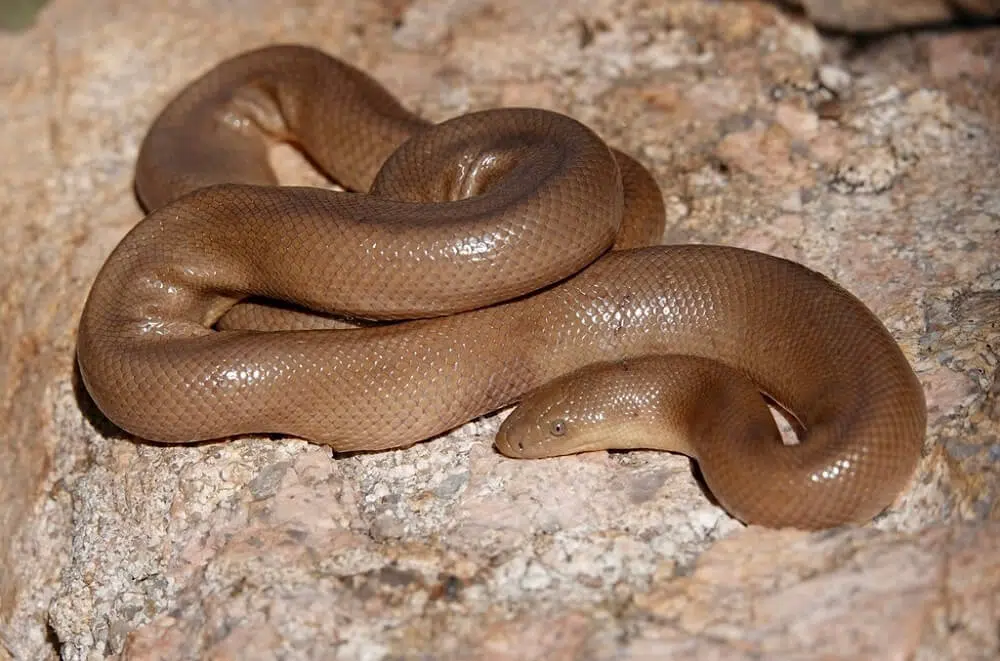
Scientific name: Charina umbratica
Common name: Southern rubber boa
Venomous: No
The Southern Rubber Boa also has a uniform color as the Northern Rubber Boa. This snake is mostly seen in either a light brown or a dark brown color.
This snake species is known to live in forests, particularly in hardwood forests.
It has excellent agility as it can move quickly on the ground but it can also climb and swim.
Snakes of the species are known to eat small mammals, lizards, and even a few small birds.
It’s generally not friendly towards people but it gives off warning signs before it bites. For example, it raises its tail to mimic a strike and to put people off.
Occasionally active during the day, this snake is most active from April to June when it mates and when it temporarily renounces its solitary lifestyle.
Otherwise, these snakes are found under large objects such as logs and rocks during the day.
10. Coastal Rosy Boa

Scientific name: Lichanura orcutti
Common name: Coastal Rosy Boa
Venomous: No
Coastal Rosy Boa snakes are now part of the Rosy Boa species. Some people still refer to the Rosy Boa snakes found on the Coast as Coastal Rosy Boa.
The species is now part5 of the Rosy Boa genus together with the Desert Rosy Boa. While geographic limits apply, it turns out these 2 subspecies have been regrouped into the Rosy Boa snake species.
11. Rosy boa

Scientific name: Lichanura trivirgata
Common name: Rosy boa, desert rosy boa
Venomous: No
Like the Rubber boa, the Rosy boa is a species native to the US. It grows to a maximum size of 44 inches and it gets its name from its color.
This snake is seen in multiple colors which are impacted by dominating nuances of its environment. The snake also comes in a rose-salmon color which inspires its name.
Snakes of the species are known to live in Southern California and Baja California.
It’s considered a friendly snake as it allows people to handle it without biting.
The Rosy boa snake is known for releasing a foul odor whenever threatened.
12. Glossy snake

Scientific name: Arizona elegans
Common name: Glossy snake, faded snake
Venomous: No
Glossy snakes are known for living in California’s chaparral regions. These snakes are nocturnal and rarely seen as they prefer to crawl under rocks.
At night, the snakes feed on rodents. On occasion, it also comes out during the day. When it comes out during the day it mostly does it for prey.
Glossy snakes are often perceived as less common due to their secretive nature.
They remain hidden in rodent burrows almost all day and all night which makes them appear scarce.
13. Western shovelnose snake

Scientific name: Chionactis occipitalis
Common name: Western shovelnose snake
Venomous: No
The Western shovelnose snake is a small species that grows to a size between 11 and 17 inches.
It can be identified by its brown bands on the body.
This snake is never seen in Northern California. It lives in deserts and as a result, it’s constricted to parts of Southern California.
As a smaller snake, the Western shovelnose species doesn’t feed on mammals as it prefers insects.
It can be seen in sandy areas, on dunes, and on rocky terrains where there’s little to no vegetation.
14. Eastern racer

Scientific name: Coluber constrictor
Common name: Eastern racer
Venomous: No
Eastern racer snakes are known to be fast-moving species. They can have a uniform color or they can have various patterns.
Black Eastern racers are highly common. Rare types of coloring for the species in California include various shades of brown with or without blue undertones.
These snakes are highly common in areas with tall grass. It’s here that they raise their heads above grass levels to check out prey or predators.
Some people mistakenly believe Black racers are constrictors. But they don’t suffocate prey as their name suggests.
Black racers pin prey or they push their bodies into the prey to stop it from escaping.
15. Forest sharp-tailed snake

Scientific name: Contia longicaudae
Common name: Forest sharp-tailed snake
Venomous: No
The Forest sharp-tailed snake is one of the species in California with a different color head. These snakes have a dark color head that’s typically dark gray with olive undertones.
Its dorsal coloring is brown or black. Its underbelly is light color and characterized by black scale edges.
These forest-living snakes are rather small and very secretive. They tend to hide all day.
Some snakes of the species prefer to come out after the rain, mainly to hunt.
Members of this species are known for having sharp teeth which help them grasp slippery prey such as salamander.
16. Sharp-tailed snake

Scientific name: Contia tenuis
Common name: Brown snake, gentle brown snake, Oregon worm snake, Pacific brown snake, Pacific ground snake, purple-tailed snake, sharp-tailed snake, sharptail snake
Venomous: No
The Sharp-tailed snake is one of the small species that can be found in urban areas around California.
Sharp-tailed snakes are known to grow to a size between 12 and 18 inches. It has a sharp tail and banded body coloring.
This is a burrowing species and like all burrowing snakes, it prefers to live in soft soil where it can easily move around to find slugs.
Snakes of this species never come out in open space but they are found in gardens and parks where large stones or logs are removed.
17. Ringneck snake

Scientific name: Diadophis punctatus
Common name: Ring-necked snake, ringneck snake
Venomous: No
Ringneck snakes are a species of bicolored snakes. Their dorsal is green olive while their underbelly is bright orange or bright red.
These snakes are abundant and they live in the ground. Known as a small species, Ringneck snakes grow to a size between 10 and 15 inches.
Snakes of the genus are normally abundant in areas with slugs and salamander.
They are known to use different methods to subdue prey. First, they use constriction. Secondly, they might consider envenomation.
The species doesn’t have a specific venom gland. But they do have a small amount of venom they might use as a backup to immobilize small prey.
18. Desert nightsnake
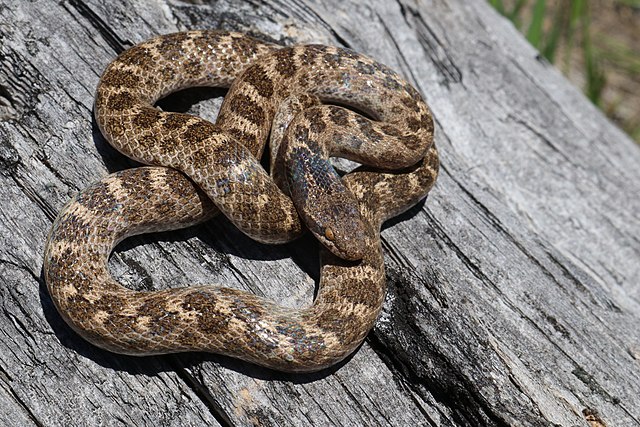
Scientific name: Hypsiglena chlorophaea
Common name: Desert nightsnake
Venomous: No
The Desert nightsnake is a species with a bright underside and blotched gray and brown dorsal coloring.
Snakes of this genus are adapted to specific California habitats such as chaparral. They like rocky terrains and grasslands as well.
In other parts of the country, these snakes are also seen in woodlands.
Growing to a size of over 15 inches, these snakes can even reach 26 inches in areas with abundant food.
Preferences toward small amphibians are what the species exhibits.
Mildly venomous, the species can even consume other animals as it uses venom to subdue prey.
One of the largest misconceptions these snakes are known for is being taken as Rattlesnakes due to their coloring.
19. Coast night snake

Scientific name: Hypsiglena ochrorhynchus
Common name: Coast night snake
Venomous: No
Common in Western California, the Coast night snake is one of the multiple nocturnal blotched snakes in the state.
The species is found in multiple colors. Its tan body and brown blotch coloring is the most common.
Snakes of the genus are known for their preference for rocky terrains.
This makes them an uncommon sight, especially since they only come out at night.
The diet of the snakes is diverse. Compared to other species, this amphibian-eating snake also eats insects.
A mature Coast night snake can reach a length of up to 26 inches.
The species is common around the Central Valley.
20. California kingsnake

Scientific name: Lampropeltis californiae
Common name: California kingsnake
Venomous: No
The California kingsnake is a common species in the state. It comes in multiple dark and white banded bodies which might make it seem like a different species whenever its colors are different.
This snake is known to be very powerful. Growing to a size of up to 3.5 feet, the California kingsnake is known for its powerful constriction.
It uses constriction against reptiles, birds, and even other types of juvenile snakes.
California kingsnakes are known to eat other snake species. They’re also known to resist the venom of Rattlesnakes.
The species even mimics Rattlesnakes to an extent. It wiggles its tail making a similar rattling sound Rattling snakes are known for.
21. Coast mountain kingsnake

Scientific name: Lampropeltis multifasciata
Common name: Coast mountain kingsnake
Venomous: No
This snake is known to be black, red, and white. It has specific circles of these colors that go around its body.
The species is adapted to being diurnal, nocturnal, or crepuscular.
It uses temperature to guide its activity levels. The Coast mountain kingsnake is most secretive during the summer months when it has a nocturnal profile.
It turns diurnal in the fall. The species goes into hiding starting in November when it can’t be seen outside anymore.
Coast mountain kingsnakes eat small mammals. They also eat birds and bird eggs.
Growing to a maximum size of 33 inches, the snakes are common in Northern parts of the state and they aren’t venomous as almost all snakes in this part of California.
22. California mountain kingsnake

Scientific name: Lampropeltis zonata
Common name: California mountain kingsnake
Venomous: No
The California mountain kingsnake is a non-venomous species known to live up in mountains.
Identifying this snake is easy as it comes with a red body with white crossbands which are always bordered by 2 black crossbands.
Snakes of the genus are mostly similar to the California kingsnake.
The species is endemic to North America. But its habitat also expands Southwards in Baja California.
23. Coachwhip

Scientific name: Masticophis flagellum
Common name: Coachwhip, whip snake
Venomous: No
Coachwhips are common snakes in California. They are part of a wide group of diurnal snakes in the state which means they can be seen frequently.
These snakes are found in grasslands, oil fields, farms, and woodlands. They are known to raise their heads above tall vegetation to make the
Their very good vision is based on their large eyes.
Snakes of the genus are also aggressive and fast. Identified by a largemouth, a thin head, and large eyes compared to the size of the head, the species should not be handled.
These snakes can grow up to 50 inches and they can inflict a painful bite. While not venomous, the bite of the snake is often quick and painful.
Snakes of the genus are known to bite without prior warning signs.
Commonly seen on sandy terrains, these snakes are also known for being able to make a quick escape after biting. They can reach speeds of up to 4 miles per hour.
24. Baja California coachwhip
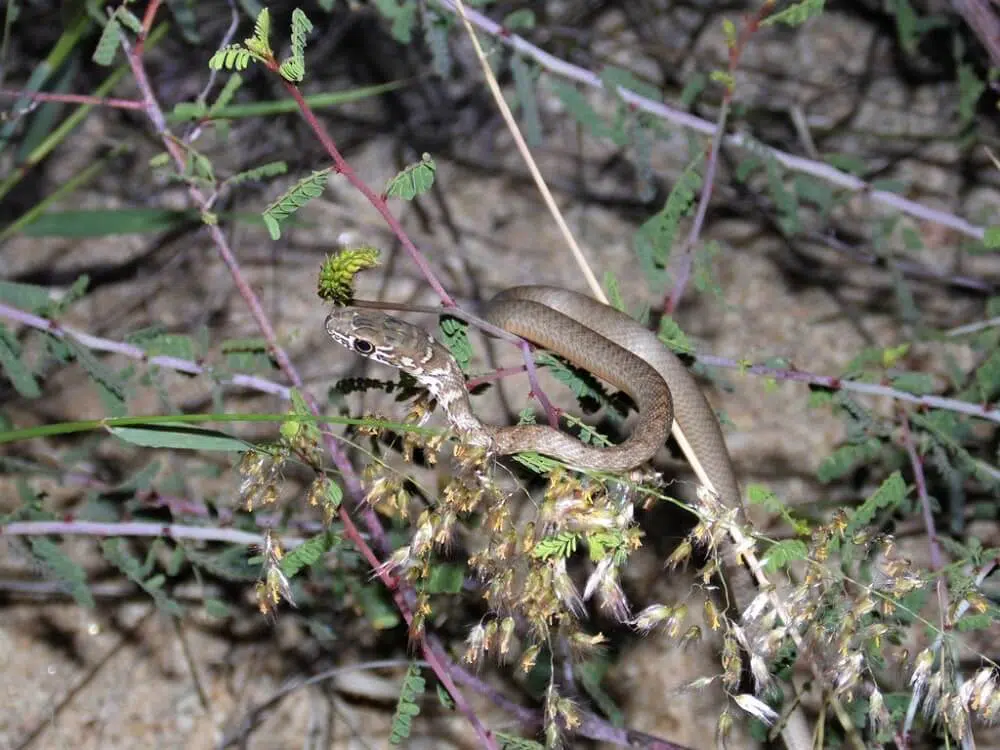
Scientific name: Masticophis fuliginosus
Common name: Baja California coachwhip
Venomous: No
The Baja California coachwhip is identified by its almost all-black body but it can be seen in gray and blotched gray colors as well.
As its name suggests, the species is mostly found in Baja California. It’s known to reproduce in the Northern Baja California territories.
It also moves over to grasslands in California throughout its life.
This snake is adapted to diurnal living. It’s commonly seen on roads where it basks in the sun during the day.
Like many snakes in the state, it has a varied diet. But it also eats bats lizards and other small snakes.
25. California striped whipsnake

Scientific name: Masticophis lateralis
Common name: California whipsnake, striped racer, California striped whipsnake
Venomous: No
This snake is found in multiple areas around the state. It’s seen in deserts, around the coast, in chaparral, and beyond.
It’s identified by its striped body. It features an olive-green color with pale yellow lines that run from head to tail.
These snakes can be seen across various terrains such as chaparral and other open spaces.
26. Striped whipsnake

Scientific name: Masticophis taeniatus
Common name: Striped whipsnake
Venomous: No
This snake species gets its name from its striped body. Bright stripes along its body make for easy identification.
Snakes of the species are non-venomous. They are found in Northern California where they inhabit grasslands and forests.
Striped whipsnakes are not particularly dangerous to people. They prefer to run away whenever seeing humans.
Striped whipsnakes are some of the fastest snake species in California.
27. Banded water snake

Scientific name: Nerodia fasciata
Common name: Banded water snake, Southern water snake
Venomous: No
Banded water snakes are aquatic. They are identified by a dark green body with white stripes, a gray body with stripes, or an orange body with stripes.
They can grow to a maximum size of 42 inches.
Snakes of the species are found in lakes and ponds. They don’t travel far from water sources.
Shared habitat with other snakes often makes people confuse the Banded water snake. Cottonmouths are some of the venomous snakes the Banded water snake is often confused with.
These snakes are considered to be increasing their habitat.
Banded water snakes also live on the outskirts of Los Angeles.
28. Western leaf-nosed snake

Scientific name: Phyllorhynchus decurtatus
Common name: Western leaf-nosed snake
Venomous: No
The Western leaf-nosed snake is identified by its gray body with dark blotches all across its body.
Some color variations are accepted for the species which include tan and even pink.
These snakes are nocturnal and they were initially seen as very rare. However, they are very active at night.
Wester leaf-nosed snakes are often found sitting on paved roads in deserts at night.
They’re also active after sunset when it comes to looking for food. They typically look for small lizards and lizard eggs.
Snakes of this species are found in Southern parts of California as well as in Baja California.
29. Gopher snake

Scientific name: Pituophis catenifer
Common name: Pacific gopher snake, coast gopher snake, Western gopher snake, gopher snake
Venomous: No
Gopher snakes grow to a size between 2.5 and 9 feet.
This snake is one of the most versatile in the state. It can travel on the ground and swim. It can also climb trees.
Gopher snakes use constriction to catch small animals. They eat pocket gophers and rodents. They can also eat rabbits and birds.
These hissing snakes aren’t venomous and are not particularly dangerous to people.
They are mostly seen in the spring when males are actively seeking out females for reproduction.
Gopher snakes are also known to play dead. They can lay still for a long time to appear dead.
30. Long-nosed snake

Scientific name: Rhinocheilus lecontei
Common name: Long-nosed snake
Venomous: No
This snake is known to resemble Coral snakes. It has an upward-facing snout and a red and black body that makes it similar to venomous snakes.
Long-nosed snakes are known to eat amphibians as most other snakes in the state. A rare sight, this snake is nocturnal rarely getting out during the day.
It can be found in grasslands where it remains in a shaded place during the day.
These snakes are adapted against common predators such as larger snakes. They are known for releasing a foul smell and even blood to appear dead while remaining motionless.
Snakes of the genus can be seen in late spring and early summer when mating takes place.
31. Western patch-nosed snake

Scientific name: Salvadora hexalepis
Common name: Western patch-nosed snake
Venomous: No
This small snake is common in desert scrubs. As a diurnal species, it can often be seen chasing all types of small prey.
Its diet is comprised of mammals, lizards, and grasshoppers. It also eats the eggs of other snakes.
These striped snakes are known for having a large rostral scale on the nose.
Snakes of the genus aren’t dangerous to humans.
Generally seen as docile, they can also be considered good pet snakes.
32. Western ground snake
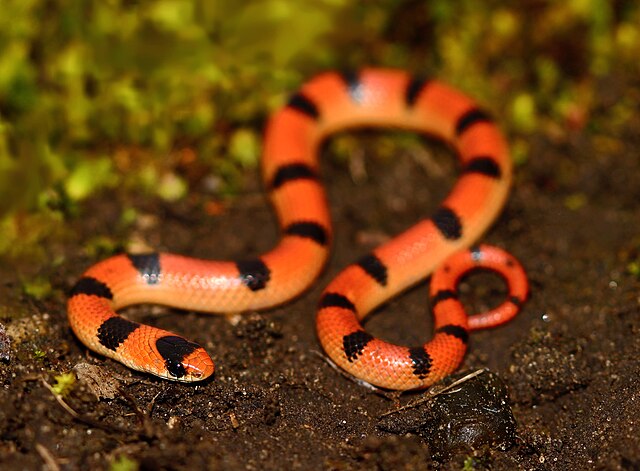
Scientific name: Sonora semiannulata
Common name: Western ground snake, common ground snake, variable ground snake
Venomous: No
Western ground snakes live on the loose ground in rocky areas.
This snake is mostly known to be orange with black stripes on its dorsal side. However, it’s found in many other colors, mainly due to inbreeding.
The snake lives underground where it prefers to hide. It comes out to eat a wide range of insects and invertebrates.
Western ground snakes are known to eat spiders. They can also eat other insects such as crickets and centipedes.
Females of the species lay eggs as they don’t carry live young snakes.
These females are known to lay eggs through the summer soon after mating.
33. Southwestern blackhead snake

Scientific name: Tantilla hobartsmithi
Common name: Southwestern blackhead snake, Smith’s blackhead snake, Smith’s black-headed snake
Venomous: No
The Southwestern blackhead snake is native to Southwest US and Mexico. This is a small species that grows, on average, to 8 inches.
Identified by its small body and its brown coloring, the Southwestern blackhead snake is known for eating all types of insects. It prefers softer insects that are easier to chew.
These snakes aren’t dangerous to mammals and humans. Only mildly venomous, they do not have sufficient toxins in their saliva to impact people.
However, their mildly venomous nature turns venomous to small insects which are paralyzed by the snake’s saliva.
Southwestern blackhead snakes are known to live in loose soil in grasslands, woodlands, and deserts.
34. Western black-headed snake
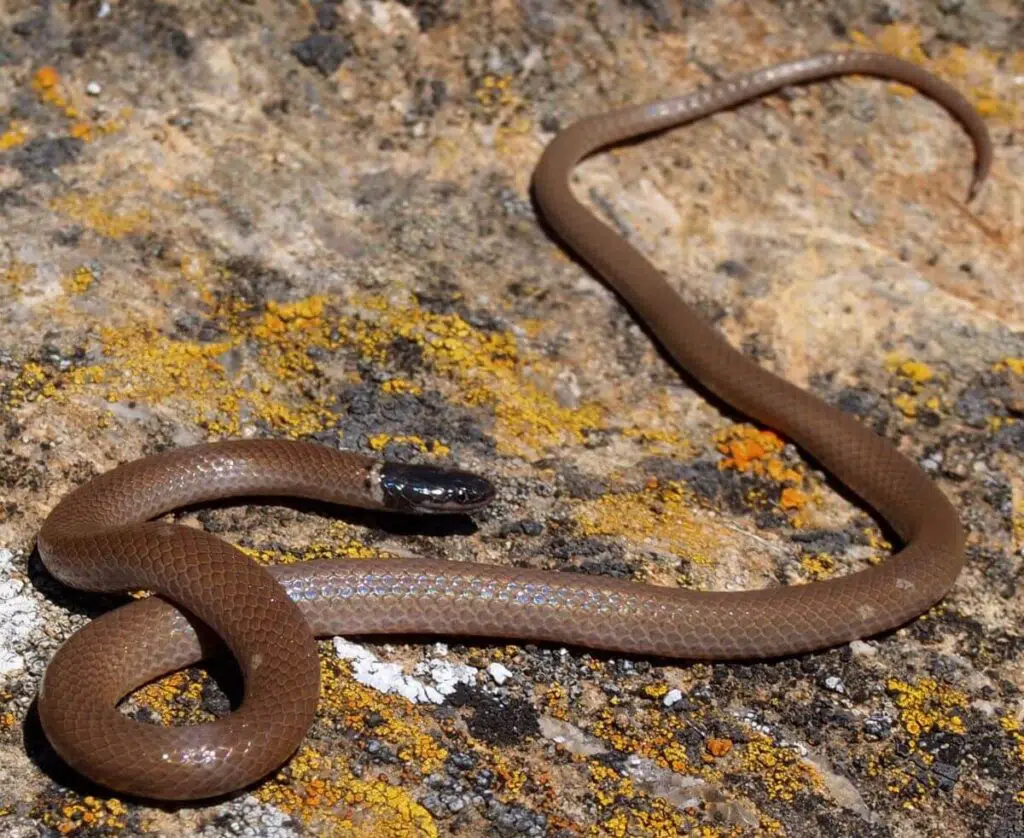
Scientific name: Tantilla planiceps
Common name: Western black-headed snake, California black-headed snake
Venomous: No
This snake is identified by its black head with a white collar and by its brown body. Snakes of the genus are small compared to other species in California.
Western black-headed snakes grow to a maximum size of 15 inches.
These snakes are secretive. They spend most of their lives underground.
Wester black-headed snakes are found in woodlands and deserts. Whenever found in deserts they seem to be tied to remote higher moisture areas of the arid terrains.
35. Aquatic garter snake

Scientific name: Thamnophis atratus
Common name: Aquatic garter snake
Venomous: No
As its name suggests, this snake species is aquatic. Snakes of the genus are typically green and further characterized by having long yellow stripes that run from the head to the tip of the tail.
This helps these snakes remain undetected in marshes and bushland.
Snakes of the genus are known to use their coloring as camouflage.
They can swim under the surface level and flick their tongues out which makes some of their prey think they’re seeing flies.
36. Sierra garter snake

Scientific name: Thamnophis couchii
Common name: Couch’s garter snake, Sierra garter snake, Western aquatic garter snake
Venomous: No
The Sierra garter snake is one of the aquatic species known for its adaptability. The species is known for being active almost all year.
Snakes of the genus are often found in or next to rivers. These black snakes can also swim at the bottom of rivers looking for fish.
Apart from eating fish, these snakes can also eat amphibians they find next to rivers and streams.
It was initially believed this species was poisonous. But the snakes had toxins in their body from the salamander they eat.
These toxins of salamanders can remain inside the snake for up to a few weeks.
37. Terrestrial garter snake

Scientific nameb: Thamnophis elegans
Common name: Western terrestrial garter snake, terrestrial garter snake
Venomous: No
The Terrestrial garter snake specie is known to grow to a maximum length of 41 inches.
These colorful snakes often have long white stripes on their bodies.
The Terrestrial garter snake is a constricting species which means it uses force to constrict prey.
It may be one of the few constricting garter snakes that routinely use this tactic of overpowering terrestrial prey such as rodents.
38. Giant garter snake

Scientific name: Thamnophis gigas
Common name: Giant garter snake
Venomous: No
This snake is either green-olive, brown, or black. It has a white or yellow dorsal stripe regardless of its main color as well as a bright underbelly.
The species is mostly aquatic. However, it uses vegetation near water sources to hide. It can also use the burrows of animals to cool off during the hot days of summer.
Snakes of this species are known to have a diet that represents this semi-aquatic nature.
They eat fish, frogs, and tadpoles.
Giant garter snakes get their name from their large bodies.
They grow to a size between 35 and 65 inches which makes them larger than many other snake species in California.
39. Two-striped garter snake

Scientific name: Thamnophis hammondii
Common name: Two-striped garter snake
Venomous: No
This snake gets its name from the stripes that run along its body. However, the Two-striped garter snake can also have no stripes.
Snakes of the species use their green coloring to stay out of sight for many predators and prey as they are found in semi-permanent water sources.
They can approach a wide range of prey due to their camouflage.
The species is known for eating amphibians alongside fish.
It can be found in central parts of California and further South in Baja California.
40. Checkered garter snake

Scientific name: Thamnophis marcianus
Common name: Checkered garter snake
Venomous: No
These snakes are identified by their green bodies with a checkerboard appearance.
Mildly venomous, the species is particularly dangerous to small fish and earthworms.
These snakes are also known for having the digestive capacity to eat toads.
Checkered garter snakes like to live in grassland. Ideally, this grassland is next to a source of water where the snake can find all types of amphibians as it prefers them to rodents.
41. Northwestern garter snake

Scientific name: Thamnophis ordinoides
Common name: Northwestern garter snake
Venomous: No
Known to be brown, green, or gray, these snakes are known to live up to 15 years.
They are known as solitary species but they use pheromones to attract the opposite sex in their mating period.
These snakes are generally afraid of people. They try to escape when seeing humans. The easiest route to disappear involves crawling into vegetation.
Largely terrestrial and diurnal, this snake species is frequently seen in the state.
These snakes are known for eating slugs but they can also eat fish whenever they go hungry.
Snakes of the species have also been known to eat other types of prey. Reports show this snake can also eat toads and otherwise toxic salamander.
The species is known for living in very specific areas of the state. It can only be found in the furthest Northern California territories as well as in Oregon.
42. Common garter snake

Scientific name: Thamnophis sirtalis
Common name: Common garter snake
Venomous: No
Known for being seen in different colors, the Common garter snake typically has 3 long stripes on its body.
These snakes are known to grow up to 55 inches and they have been thought to live up to 10 years outside captivity.
A solitary species, the Common garter snake is only seen communicating with other snakes of its species during the mating season.
These snakes are seen as efficient predators of various small fish and amphibians.
The Common garter snake also has many natural predators such as crows and hawks.
Like other species of the Garter genus, these snakes can also eat toads. Most toads are toxic and even deadly if eaten by other animals.
The Common garter snake is immune to the toxic skin of toads.
43. Sonoran lyre snake
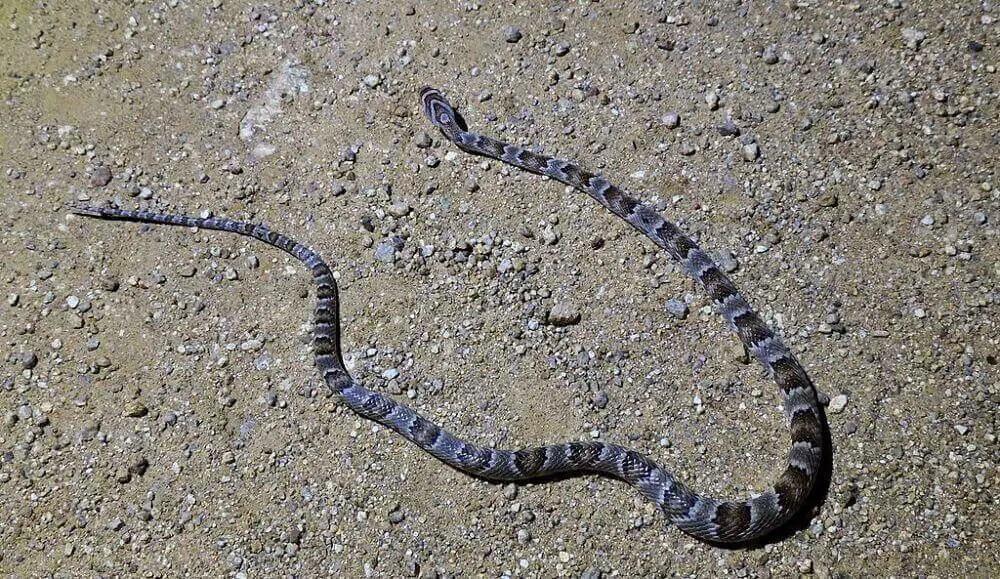
Scientific name: Trimorphodon lambda
Common name: Sonoran lyre snake
Venomous: No
The Sonoran lyre snake is one of the mildly venomous species in California. This snake’s venom isn’t considered a major concern for humans.
However, these snakes should still not be handled as they’re known to bite. Poisonous saliva from these snakes is known to cause pain and red skin.
Snakes of the species are nocturnal in California. They aren’t easy to see and they become even more secretive during the mating process.
Known to feed on lizards, these snakes can grow past 40 inches depending on their habitat.
Recognized by their brown or gray bodies that mimic their habitat, snakes of the species employ defensive mimicry techniques.
They vibrate their tails like Rattlesnakes to avoid being eaten by other predators.
Snakes of the species are also known to raise their heads quickly and strike a bite whenever a predator or people get close to them.
44. California lyresnake

Scientific name: Trimorphodon lyrophanes
Common name: California lyresnake
Venomous: No
This species is endemic to California. It’s identified by its small to medium-sized body that grows up to 47 inches and by its vertical pupils that resemble the eyes of cats.
Snakes of the genus are gray and brown.
This snake is known to be mildly venomous. It can be lethal to small animals but not deadly to humans.
Its bite is considered very painful when it grabs onto a hand or a leg getting the chance to insert more saliva using its strong fangs.
These snakes are nocturnal. They may be seen looking for food both in good weather and during heavy rainfall.
Snakes of the genus are seen eating lizards and looking for lizards soon after the rain stops.
Mating occurs in the spring and female snakes are known to lay eggs at the beginning of the summer. These snakes can lay clusters of up to 10 eggs.
45. Western threadsnake

Scientific name: Rena humilis
Common name: Western blind snake, Western slender blind snake, Western threadsnake
Venomous: No
The Western threadsnake is one of the common species in California that’s hard to see. These are burrowing snakes that always live in the ground.
While rarely seen, these snakes that resemble earthworms are common. They have a pink color and a slender body.
Western threadsnakes are known for having a robust small head which helps with digging.
Snakes of the genus aren’t common at ground level even when it rains as they’re known to dig deep.
Snakes of the genus can go as deep as 66 feet underground.
Feeding is limited to small insects. These snakes are normally known to invade ant nests where they consume multiple ants at once.
Snakes of the species are also known to be blind. Evolutionary perspective means they have no vision since they don’t need it for a life spent underground.
46. Brahminy blind snake

Scientific name: Indotyphlops braminus
Common name: Brahminy blind snake, flowerpot snake, common blind snake, island blind snake, teliya snake, Hawaiian blind snake
Venomous: No
As the Western threadsnake, the Brahminy blind snake also lacks vision.
These snakes are fossorial which means they also live underground. Most commonly, these snakes are confused with earthworms.
The biggest difference between the Brahminy blind snake and earthworms is the scales on its body.
Not much is known about these snakes due to them living underground.
However, it turns out that all studied snakes of the genus were female. This is known as parthenogenesis. The female lays eggs or even gives birth to young female snakes without mating.
The newly-emerged snakes have the same genetic structure as the female.
Snakes of the genus are known to live on farms and in suburban areas. They depend on higher soil humidity and they cannot survive in very dry soil.
Some snakes of the genus might be found hiding under logs and rocks as long as there’s sufficient humidity.
Otherwise, these small snakes move around looking for food. They prefer to eat ants or termites.
There’s growing evidence to show these snakes can even live in ant nests for up to a few days to eat more ants.
Further Reading: